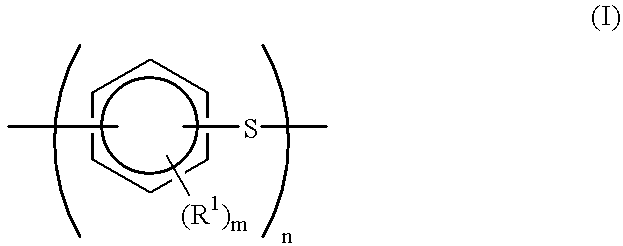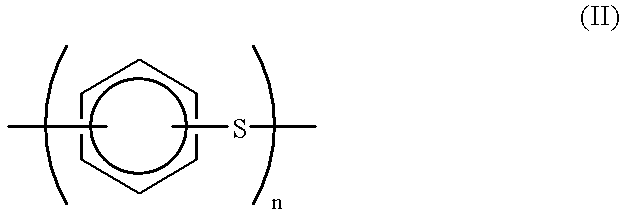Production process for polyarylene sulfide
a polyarylene sulfide and production process technology, applied in the field of polyarylene sulfide, can solve the problems of inferior reduced heat stability of pas, and inability to obtain pas having a high molecular weigh
- Summary
- Abstract
- Description
- Claims
- Application Information
AI Technical Summary
Benefits of technology
Problems solved by technology
Method used
Image
Examples
example 1
An autoclave having a volume of 1 liter was charged with 23.1 g (0.503 mole) of lithium sulfide, 1.96 g (81.8 millimole) of anhydrous lithium hydroxide and 188 ml of NMP and maintained at 215.degree. C. Added thereto was a solution, which was heated in advance to 100.degree. C., of 75.3 g (0.512 mole) of p-dichlorobenzene, 6.46 g (0.359 mole) of water and 75.3 ml of NMP to carry out pre-polymerization at 200.degree. C. for 5 hours. Then, the temperature was elevated up to 260.degree. C. to carry out polymerization for 3 hours. A revolution of the stirring blades was set to 320 rpm. After finishing the polymerization, the temperature was lowered down to 100.degree. C. to filter a granular polymer precipitated. The polymer thus obtained was washed twice with hot water and washed lastly with acetone. This was vacuum-dried at 120.degree. C. for 12 hours to obtain PAS. The resulting PAS was subjected to the heat stability experiment. The result thereof is shown in Table 1.
example 2
The same operation as in Example 1 was carried out to obtain PAS, except that 10.1 g (81.8 millimole) of lithium N-methylaminobutyrate was substituted for anhydrous lithium hydroxide. The resulting PAS was subjected to the heat stability experiment. The result thereof is shown in Table 1.
example 3
The same operation as in Example 1 was carried out to obtain PAS, except that 39.3 g (0.503 millimole) of anhydrous sodium sulfide (manufactured by Sankyo Chemicals Co., Ltd.) was substituted for lithium sulfide. The resulting PAS was subjected to the heat stability experiment. The result thereof is shown in Table 1.
PUM
| Property | Measurement | Unit |
|---|---|---|
| mole ratio | aaaaa | aaaaa |
| mole ratio | aaaaa | aaaaa |
| temperature | aaaaa | aaaaa |
Abstract
Description
Claims
Application Information
 Login to View More
Login to View More - R&D
- Intellectual Property
- Life Sciences
- Materials
- Tech Scout
- Unparalleled Data Quality
- Higher Quality Content
- 60% Fewer Hallucinations
Browse by: Latest US Patents, China's latest patents, Technical Efficacy Thesaurus, Application Domain, Technology Topic, Popular Technical Reports.
© 2025 PatSnap. All rights reserved.Legal|Privacy policy|Modern Slavery Act Transparency Statement|Sitemap|About US| Contact US: help@patsnap.com


